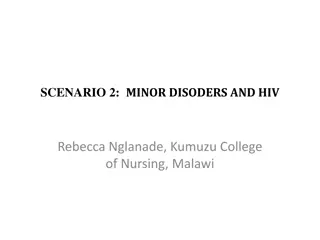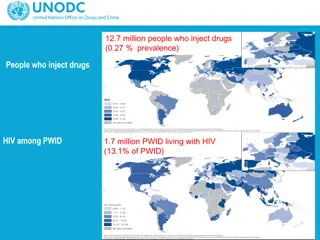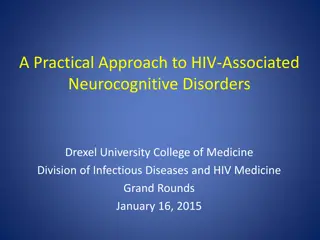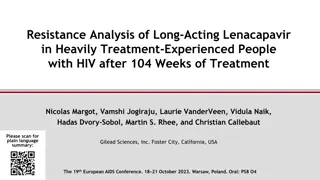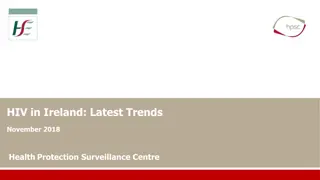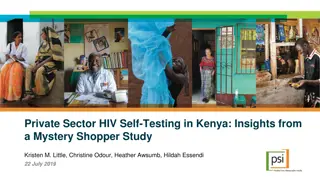West Sussex HIV Testing Plan: Strategies for Improved Diagnosis and Treatment
West Sussex's HIV testing plan for 2022-2025 focuses on reducing domestic transmissions by implementing targeted strategies in primary and secondary care settings. While overall prevalence is low, certain areas in West Sussex exhibit higher rates, necessitating tailored testing approaches. The plan emphasizes early diagnosis and treatment to combat morbidity, mortality, and transmission risks associated with late HIV diagnoses. By learning from retrospective investigations on missed testing opportunities, the program aims to identify indicator conditions and demographics that can guide proactive testing initiatives. Implementing evidence-based practices and leveraging national action plans are key priorities to achieve the goal of zero domestic HIV transmissions by 2030.
Download Presentation

Please find below an Image/Link to download the presentation.
The content on the website is provided AS IS for your information and personal use only. It may not be sold, licensed, or shared on other websites without obtaining consent from the author. Download presentation by click this link. If you encounter any issues during the download, it is possible that the publisher has removed the file from their server.
E N D
Presentation Transcript
West Sussex HIV Testing plan: Primary care 2022-2025 West Sussex Sexual Health & HIV team January 2023
West Sussex HIV Testing plan: Primary care 2022-2025 UK is committed to achieving zero domestic HIV transmissions by 2030 West Sussex HIV prevalence overall considered low HOWEVER some areas have high prevalence i.e. Worthing 2.39/1000 and Crawley 3.62/1000 Failure to diagnose & treat HIV impacts negatively on individual morbidity/mortality and ongoing HIV transmission 6% of people living with HIV in UK remain undiagnosed. This has improved significantly from 33% two decades ago HOWEVER the last 6% will be the hardest to target. New HIV diagnoses in men who have sex with men has fallen below that of heterosexuals in the UK for the first time. This is due to increased testing in MSM, upscaling of HIV treatment and availability of HIV PrEP HOWEVER 50% of individuals are still diagnosed late; this is associated with 8 x risk of death, increased morbidity, health care related cost and poorer response to treatment Late diagnosis predominantly in older, white, heterosexuals; those not traditionally seen as at risk of HIV We need an evidenced based approach to implementing the UK governments action plan* locally *https://www.gov.uk/government/publications/towards-zero-the-hiv-action-plan-for-england-2022-to-2025 2 West Sussex HIV Testing plan: Secondary care 2022-2025
West Sussex HIV Testing plan: Primary care 2022-2025 In areas of extremely high prevalence (>5/1000) it is cost effective to implement opt out HIV testing in ED s and MAUs. UHS have introduced such a highly successful programme in Brighton. In lower prevalence areas (West Sussex) the focus is on; Testing specific risk groups e.g. Sexual Health, Antenatal, Termination of pregnancy, Substance misuse and TB / Hepatitis / Lymphoma services Testing individuals presenting with AIDS defining conditions eg PCP pneumonia Testing individuals presenting with conditions associated with a higher HIV prevalence; HIV INDICATOR CONDITIONS In depth retrospective investigation of missed opportunities to test for HIV in all individuals diagnosed late in West Sussex has identified trends in specific indicator conditions and patient demographics This data has informed this HIV testing programme for secondary and primary care launching Jan 23 3 West Sussex HIV Testing plan: Primary care 2022-2025
Learning from retrospective investigations of missed opportunities to test for HIV in late diagnoses West Sussex Indicator conditions: most common; thrombocytopenia (can be mild), leukopenia, lymphadenopathy, recalcitrant dermatological conditions (psoriasis, seborrheic dermatitis), weight loss ?cause and diarrhoea ?cause. Several patients had history of Infectious Mononucleosis like presentations and were tested for EBV. In retrospect these were likely to represent HIV seroconversion illness (a unique opportunity to diagnose and treat early!) Demographics: In keeping with national data the burden of late diagnosis locally is seen in older, white, middle class, heterosexual individuals. ACTIONS: 1) Recommend HIV indicator condition testing for all (see speciality based crib sheet slide 6) 2) Consider the PRESENTATION and not INDIVIDUAL DEMOGRAPHICS when deciding on HIV testing 4 West Sussex HIV Testing plan: Primary care 2022-2025
How to test for HIV Qualitative research demonstrates that HIV testing is widely accepted by patients with the main barrier to testing being health care practitioner related HIV testing does not require a special form of consent or counselling. Explain that it is routine to test for HIV in view of their presentation; this negates the need to take a sexual history or identify any other potential HIV risk factors. Asking a patient if they would like an HIV test, or if they feel that they need a test, is potentially stigmatising and likely to result in lower testing uptake. A gold- topped sample bottle of blood should be sent to microbiology for HIV Ag/Ab If the test is reactive microbiology will inform the responsible Consultant and local HIV team. Let the patient know as soon as practicable and contact the local HIV team for further advice and follow up. www.sexualhealthwestsussex.nhs.uk 01903 285199 (Worthing/Chichester/Crawley) or consultant-on-call via UHS switchboard Further details available in the Trust HIV Testing Guidelines on the intranet including patient information leaflets 5 West Sussex HIV Testing plan: Primary care 2022-2025
Towards Zero: the HIV Action Plan for England - 2022 to 2025 Based on local data: West Sussex Indicator Conditions for prioritising HIV testing Primary Care Consider the condition not the patient characteristics Does this person have a common HIV Indicator condition? Unexplained fever, lymphadenopathy, weight loss or diarrhoea Unexplained leukocytopenia or thrombocytopenia Glandular fever-type illness Community acquired pneumonia Herpes zoster Inform the patient that HIV testing is recommended and should be included as a routine investigation Pre-test counselling and special consent are not required For further advice contact your local Sexual Health service : Worthing/Chichester - 01903 285199; www.sexualhealthwestsussex.nhs.uk Brighton/Hove - 01273 523388; www.brightonsexualhealth.com Towards Zero: the HIV Action Plan for England 2022 to 2025 - GOV.UK (www.gov.uk)











